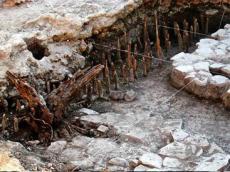|
|
TODAY.AZ / Weird / Interesting
Mexican archaeologists discover ' unusual ' Aztec burial
10 August 2012 [15:34] - TODAY.AZ
 Mexican archaeologists say they have found an unprecedented human burial in which the skeleton of a young woman is surrounded by piles of 1,789 human bones in Mexico City's Templo Mayor.
Mexican archaeologists say they have found an unprecedented human burial in which the skeleton of a young woman is surrounded by piles of 1,789 human bones in Mexico City's Templo Mayor.Researchers found the burial about five metres (15ft) below the surface, next to the remains of what may have been a sacred tree at one edge of the plaza, the most sacred site of the Aztec capital.
The National Institute of Anthropology and History said the find was the first of its kind, noting the Aztecs were not known to use mass sacrifice or the reburial of bones for the interment of a member of the ruling class.
University of Florida archaeologist Susan Gillespie, who was not involved in the project, called the find "unprecedented for the Aztec culture".
She said on Tuesday that when the Mayas interred sacrifice victims with royal burials, but they were usually found as complete bodies. And, except for special circumstances, the Aztecs, unlike other pre-Hispanic cultures, usually cremated members of the elite during their rule from 1325 to the Spanish conquest in 1521.
"Although the bodies of sacrificial victims have been found in burials of elite persons in Mesoamerica going back to at least the preclassic period, funerary deposits for Aztec elites have only rarely been encountered," said Gillespie.
The institute said some of the bones showed what may be cut marks to the sternum or vertebrae, places where a ritual heart extraction might leave a mark, but added that it did not seem likely the dead were sacrificed on the spot to accompany the burial because their bones were found separated.
The researchers discovered the skulls of seven adults and three children in one pile, long bones including femurs in another grouping, and ribs in another.
The physical anthropologist Perla Ruiz, who was in charge of the dig, said that might suggest the bones were disinterred from previous burials and reburied with the woman. While some pre-Hispanic cultures disinterred bones as part of ancestor worship, it is not clear the Aztecs did.
The burial dates to about 1481-1486, based on the "stage" of temple buildings at which they were found. The Templo Mayor, like many sites, was rebuilt by successive generations, one stage atop another.
Another unusual finding was the sacred tree, actually a rather battered oak trunk found planted on a small, round platform near the burial at what would have been the edge of the temple complex. It may be a couple of decades older than the burial.
The Aztecs, like other pre-Hispanic cultures, venerated trees, believing they had spiritual importance.
Institute archaeologist Raúl Barrera said it may be related to the four sacred trees the Aztecs believed held up the sky, but Gillespie noted it could also have been a tree or trunk brought in for an annual ceremony.
"It seems to have been positioned there for a span of time, perhaps for a special ceremony or to create a particular vision of a sacred landscape, but then abandoned as uses of that limited sacred space changed over time," Gillespie said.
Barrera said the tree trunk appeared to have been split, perhaps intentionally.
/guardian.co.uk/
URL: http://www.today.az/news/interesting/111089.html
 Print version
Print version
Views: 2258
Connect with us. Get latest news and updates.
See Also
- 05 February 2025 [19:41]
Japan plans to negotiate with Trump to increase LNG imports from United States - 23 January 2025 [23:20]
Dubai once again named cleanest city in the world - 06 December 2024 [22:20]
Are scented candles harmful to health? - 23 November 2024 [14:11]
Magnitude 4.5 earthquake hits Azerbaijan's Lachin - 20 November 2024 [23:30]
Launch vehicle with prototype of Starship made its sixth test flight - 27 October 2024 [09:00]
Fuel prices expected to rise in Sweden - 24 October 2024 [19:14]
Turkiye strikes terror targets in Iraq and Syria - 23 October 2024 [23:46]
Kazakhstan supplied almost entire volume of oil planned for 2024 to Germany in 9 months - 23 October 2024 [22:17]
Taiwan reported passage of Chinese Navy aircraft carrier near island - 23 October 2024 [21:50]
Russia remains largest oil supplier to India
Most Popular
 Foreign Ministers of China, South Korea and Japan hold meeting in Tokyo
Foreign Ministers of China, South Korea and Japan hold meeting in Tokyo
 Istanbul Airport witnesses growth in number of passenger & cargo traffic
Istanbul Airport witnesses growth in number of passenger & cargo traffic
 The Trans-Caspian route in the mirror of Azerbaijani-Chinese relations
The Trans-Caspian route in the mirror of Azerbaijani-Chinese relations
 MÜS?AD outlines strategic steps for economic resilience
MÜS?AD outlines strategic steps for economic resilience
 Azerbaijani books donated to Turkiye's Rami Library
Azerbaijani books donated to Turkiye's Rami Library
 Azerbaijan Trade House in Lahore opens new chapter in economic relations with Pakistan
Azerbaijan Trade House in Lahore opens new chapter in economic relations with Pakistan
 Somali Spaceport project aims to boost defense capabilities
Somali Spaceport project aims to boost defense capabilities
